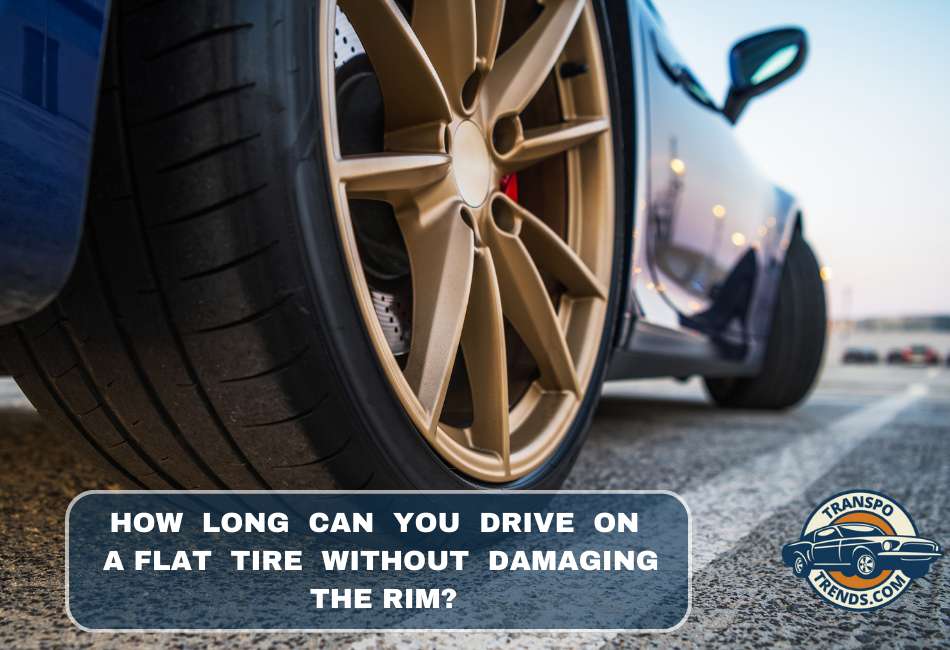Driving on a flat tire is a common problem that motorists face, but doing so can potentially cause damage to the rim.
This introductory guide is designed to provide a comprehensive understanding of the potential risks associated with driving on a flat tire and the limits within which you can still avoid damaging your rim.
It is crucial to understand these limits to minimize any possible risks. We will delve deep into the different types of wheels and how they react to such situations, factors that affect the extent of the damage, and, most importantly, we will equip you with some valuable driving tips for when you find yourself in this predicament.
Types of Wheels and Susceptibility to Damage
Steel Wheels
- Characteristics of Steel Wheels
From my experience, steel wheels are the old faithful of the automotive world. They exhibit high strength and durability, especially under heavy loads and harsh driving conditions.
The rigidity of steel wheels makes them less likely to bend under pressure, which is helpful when you have a flat tire.
- Observation: Flat Tire Behavior on Steel Wheels
I’ve observed that steel wheels hold up better than others when driving on a flat tire. This is due to their robust construction and resilience.
However, don’t get complacent; extended driving on a flat tire, even with steel wheels, can still result in damage.
Aluminum Wheels
- Characteristics of Aluminum Wheels
Aluminum wheels, which I’ve always found to be more stylish, are considerably lighter than their steel counterparts.
They offer improved handling and fuel efficiency due to their lightweight construction. But here’s the kicker: their softer material makes them more susceptible to damage.
- Comparative Ease of a Tire Coming Off the Bead
I’ve seen that tires mounted on aluminum wheels tend to come off the bead more easily when flat.
The softer nature of aluminum wheels, combined with their tendency to heat up more quickly, contributes to this occurrence.
If you continue to drive, this situation can escalate quickly, leading to more damage.
Things Influencing Rim Damage
Relationship between Bead Retention and Rim Damage
I’ve seen this far too often; drivers underestimate the relationship between bead retention and rim damage. Think of the bead as a seal between your tire and the wheel.
When this seal is broken, as it often is in the case of a flat tire, it can lead to significant rim damage. I recall a time when I was driving my old pickup on a fervently hot day.
I had a flat, and the bead broke before I could pull over, causing a dent in my sturdy steel wheel that was quite a pain to repair.
Unpredictability due to External Factors
No matter how careful or experienced a driver you are, external factors like road conditions can be unpredictable.
You’re driving on a rough country road, a tire goes flat, and before you know it, a sharp rock forces an abrupt and unfortunate meeting with your aluminum wheel.
I’ve been there, and trust me, preventing such situations is better than dealing with the aftermath.
Old Magnesium Wheels and Their Occasional Use
There was a time when Magnesium wheels were all the rage. They were lighter than aluminum and had their unique appeal.
I had a set on my first car, a sweet ’67 Mustang, and boy, they were something! However, they are more brittle and prone to cracking under stress.
While they aren’t as common today, you’ll occasionally see them, especially on classic and racing cars.
Minimizing Damage for Both Steel and Aluminum Wheels
Ultimately, no matter what type of wheels you have, the goal is to minimize damage. After all, every dent and crack can affect your ride’s safety and performance.
I remember neglecting a minor bend on my aluminum wheel once. Over time, it became a major issue requiring a complete wheel replacement.
Whether you’re rolling on steel or aluminum, remember to treat your wheels carefully. Your safety, as well as your wallet, will thank you!
Driving Tips to Minimize Rim Damage
Adopting smart driving practices is one of the most effective ways to protect your wheels from damage. Here are some important guidelines I’ve learned over the years:
Driving until the bead comes off the edge of the rim
- Significance of the bead staying on:
The bead is the inner edge of your tire that sits against the rim. Having experienced tire troubles numerous times, I can tell you that losing the bead off the edge of the rim can be disastrous.
It exposes the rim to direct contact with the road, potentially leading to dents and chips, but it can also make controlling the car much more difficult.
I once had a tire blow on a high-speed freeway, and maintaining the bead on the rim edge helped me safely maneuver to the side.
Slow down to reduce heat build-up
- Heat as a tire destroyer:
Heat is a silent killer when it comes to tires. I remember driving through the scorching desert on a summer day with my foot heavy on the gas pedal.
Before I knew it, the heat build-up had caused my tire to burst. I then learned heat build-up from high speeds can degrade the rubber significantly.
- Correlation between speed and tire longevity:
From my experience, maintaining a moderate speed enhances safety and increases tire longevity.
The faster you go, the more heat you generate, and your tires wear. Remember, it’s not a race. Drive at a comfortable and safe speed for you and your wheels.
Importance of maintaining some air in the tire
- Tire behavior when completely out of air:
A tire without air is like a fish out of water. It can’t function. I once had my tire completely deflate while driving a relatively short distance to a repair shop.
The resulting damage to both the tire and rim was costly. Driving on an entirely flat tire is like grinding your wheels against the road, leading to significant rim damage.
- Extending the life of a flat tire by retaining some air:
Sometimes, getting to the repair shop with a flat tire is inevitable. Trying to keep some air in the tire, as little as it might be, can be a lifesaver.
I’ve found that maintaining some air provides a small cushion for the rim against the hard road surface, extending the life of both the tire and the wheel.
Conclusion
In my driving journey, I’ve understood the importance of recognizing the different wheel types and how each requires specific care.
Just as humans are unique, the same can be said for tires. The factors influencing tire and rim damage range from the heat build-up from high speeds to driving distances on completely deflated tires.
Always remember that driving is not a race; maintaining moderate speeds is safer and increases your tires’ longevity.
Rim damage is like the hidden monster under a child’s bed. You never know when it’s going to pop out and give you a scare.
I’ve had instances where my rims were damaged even after I thought I had taken all the necessary precautions.
Rim damage can be unpredictable and sneaky, reiterating the necessity of taking good care of your tires.
We all know that flat tires can be a nightmare, especially when you’re in a hurry or in the middle of nowhere.
But, as I’ve learned from personal experience, it’s crucial to act responsibly when faced with a flat tire.
Even if it’s just a short distance to the repair shop, try maintaining some air in the tire. It might seem like a small act, but trust me, it can save you from significant rim damage and extend the life of your tire.
Understanding your tires and rims is about understanding their limits in the grand scheme of things. Just like us, they have a breaking point.
As drivers, we are responsible for protecting them, ensuring our safety, and prolonging their lives.
This journey has taught me how to better care of my tires, and I hope it does the same for you. Here’s to many more safe and tire-friendly drives in the future!

